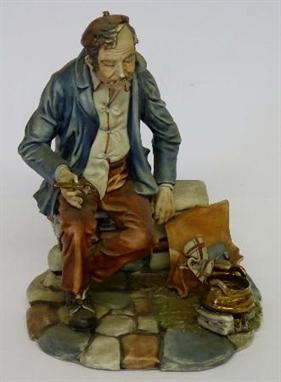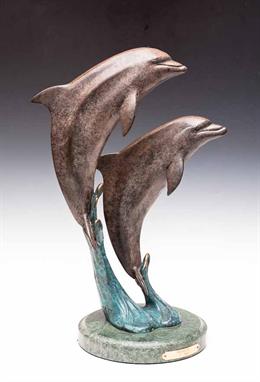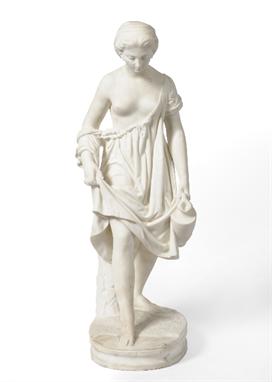We found 6684 price guide item(s) matching your search
There are 6684 lots that match your search criteria. Subscribe now to get instant access to the full price guide service.
Click here to subscribe- List
- Grid
Romanelli Fratelli, a quite superb 19th century white Marble Sculpture of the Goddess Venus in a standing pose leaning against a tree stump with two puttoes clinging to a Dolphin, it`s tail held aloft, the oval integral base signed `Romanelli Flli, Firenze``, 31`` tall approx. Minor damage to hands - right hand two finger tips missing and one fragment glued, left hand three fingers glued and one detached but present.
A fine old dark green, white veined Marble Plinth in three sections, the tapering column support having spiral fluting and standing on an octagonal base and with a circular capital/platform to the top, 11 1/4`` diameter, 39 1/2`` high approx. Although from a different vendor this would be ideal for the display of the preceding lot, contrasting superbly with the white Marble of the Romanelli sculpture.
A pair of bronze figures, early 19th century, modelled as a male and a female in 18th century dress, each approx 12cm high; also a bronze model of Cupid, early 19th century, possibly Italian, mounted on a yellow marble oval base; a naive bronze sculpture of a crouching naked woman, approx 8cm high and a Continental bronze pictorial panel, 19th century, depicting monks feeding birds, approx 20cm x 17cm. (5)
Otto Banninger (Swiss 1897-1973), a sculpted red-brown veined marble model of a male torso and a companion sculpted red-brown veined marble model of a female torso by the same hand, the male torso signed and dated to the right hand rear bottom 29-30 , the contemporary companion female torso by the same hand, unsigned and incised to the right hand front top 4 Provenance: Private Swiss collection, by repute purchased from the sculptor in the early 1930 s, thence by descent to the present vendor. Celebrated as one of the great Swiss sculptors of the interwar period, Banninger began his work under the influence of his father, and went on to study under Franz Wanger in Zurich from 1910 to 1913. In 1920 he began studying at the Academie de la Grande Chaumiere under Emile-Antoine Bourdelle, quickly becoming his friend and collaborator, and completing some of the works he left unfinished at his death. In 1928, he traveled through Italy, where he concentrated on antique and Renaissance works and the above torso are clearly influenced by antique sculpture studied on these travels. Though married to the sculptor Germaine Richier from 1929 to 1951, his work does not show her influence. From 1932 to 1939, he worked both in Paris, where he showed at the Salon des Tuileries and the Salon d’Automne, and in Zurich, where he eventually moved permanently. Throughout his career, Banninger concentrated on the portrayal of the classical figure. His early works are to some extent also influenced by Rodin and Bourdelle, have a modeled, roughened surface, but during the 1930s, his surfaces began to reflect the new realism. Like Karl Geiser, Hermann Hubacher, and Hermann Haller, Banninger tended toward a renovation of the classical human figure and his works are held in the regional Beaux Arts museum of Lausanne and in the Kunstmuseum in Zurich. " The male torso, 52.5cm high approximately, the female torso, 43cm high approximately. In good condition commensurate with age, the surface with some old minute fine wear to the extremities. View on auctionatrium.com
THE FOLLOWING LOT RELATES TO THE ARTISTIC CAREER OF ERIC WINTERS, FOUNDER MEMBER OF THE SOCIETY OF PORTRAIT SCULPTORS ERIC WINTERS (BRITISH 1921-1968) A RARE AND UNIQUE LIFE SIZE BRONZE PORTRAIT BUST OF TOTTENHAM HOTSPUR AND NORTHERN IRELAND INTERNATIONAL LEGEND DANNY BLANCHFLOWER signed and dated `Eric Winters, 1960` bronze on original marble base 17.3/4in. (41.5cm) high Exhibited: London, Royal Academy, 1962, No.1191 Eric Winters represented the fifth generation of sculptors in the Winters family, learning sculpture under the experienced eye of his father Leo Hill Winters, a carver and letter designer. He went on to study at St. Martins School of Art and in April 1939 at the age of 18 was awarded the only open scholarship to attend the Royal Academy Sculpture School where he was the youngest student Eric`s studies were interrupted during the war years, only being resumed from 1947-52 when the Academy re-opened. His achievements in his student days were most impressive and include four Landseer prizes for figurative sculpture (three in 1947 and one in 1950), representation of Great Britain and bronze medal in the XVIth Olympiad Sport in Art exhibition at the Victoria and Albert Museum (1948) and travelling scholarship to France: The Edward Stott Award for a group of figures (1949) Winters exhibited annually at the Royal Academy Summer Exhibition throughout the 1950s. Driven by his early success in portraiture and genuine passion for this branch of sculpture, Eric was already starting to pave the way for the formation of a new society even before completing his studies at the Royal Academy Schools. He had a close rapport with several of his professors including Sir Charles Wheeler, Maurice Lambert and Alfred Hardiman whose influence and support were significant at the time The newly formed Society of Portrait Sculptors presented its first annual exhibition from November 1952 to December 1953. Winters was a keen exhibitor at the Society`s exhibitions in London and elsewhere, contributing to many very fine portraits over the years, probably his most well known head is that of the footballer Danny Blanchflower modelled from life and exhibited at the Society`s 1960 annual exhibition
SIR WILLIAM `HAMO` THORNYCROFT (1850-1925) Artemis and Her Hound, dated 1909, a bronze cast from a model by Hamo Thornycroft of a scantily-clad huntress carrying a bow and drawing an arrow from her quiver, with greyhound at her side, on a naturalistic base, inscribed `Hamo Thornycroft Sc` to the top of the base, inscribed and dated `Hamo Thornycroft 1909` to the side of the base, initialled `HT` twice, and titled `ARTEMIS` to the front of the base, all on a green marbled rectangular base, the bronze 25" high, 13" wide, 6 3/4" deep. Note: Originally modelled in 1879, when Thornycroft was heavily influenced by the poet and literary critic Edmund Gosse, Artemis was one of the first examples of `The New Sculpture`, seeking to re-examine Classical sculpture for a new age. In 1880 Thornycroft showed a life-sized plaster of Artemis and Her Hound at the Paris Salon. Subsequently The Duke of Westminster commissioned a life size marble statue which was exhibited at the Salon in 1882 before being installed at Eaton Hall in Cheshire. Artemis and Her Hound was well received by the critics, and one noted that `a great advance was proclaimed...by the epoch-making "Artemis"...The attitude and arrangement are altogether admirable, as well as original...from every point of view the group is beautiful`. A half-size bronze version of Artemis was exhibited by Thornycroft at the Royal Academy in 1911 [1799] and another bronze statuette at the Royal Scottish Academy in 1917-18. Literature: S. Beattie, The New Sculpture, New Haven: Yale University Press, 1983, p. 149 E. Manning, Marble & Bronze, The Art & Life of Hamo Thornycroft, London: Trefoil Books Ltd., 1982 M. H. Spielmann, British Scupture and Sculptors of To-day, London, 1901, p.39
Emiel Hartman (20th century), Falcon on a glove, bronze sculpture, signed Emiel H to base, mounted on a square black marble plinth, 88cm (34.32in). Emiel Hartman was born in South Africa, but studied at the Slade School of Art in London and served in the Royal Navy during the First World War. He was a fellow of the Royal Society of British Sculptors and held solo exhibitions at the Grosvenor Gallery, The BH Corner Gallery, and took part in group exhibitions at the Redfern Gallery, Alwyn Gallery, the Royal Academy and elsewhere.
21st Century Contemporary: A Glass Grey Marble Effect Sculpture, formed as a swirl on a square plinth base, 44cm by 41cm; 20th/21st Century: A Freestanding Glass Sculpture, modelled as a sailing boat, the upper section of blue and frosted bubble glass, the base of composition form, the base 87cm by 42cm, the sail 100cm by 48cm; and A Composition Sculpture, of convex form, inset with two frosted glass prisms, 100cm by 27cm (3)
Barbara Worth (1925-2010), ten sculptures. This collection of the work of the late Barbara Worth has been consigned for sale by her executors following her death in January 2010. It comprises 10 pieces in various styles from different stages of her career, supported by her own notes of exhibitions, lists of sculpture, photographs, press cuttings, letters and other information about her career. She was born as Barbara Wigglesworth in London in 1925 and never married, adopting the professional name of Barbara Worth. After the War she worked as a Youth Leader until taking up a place at London University and obtained a Diploma in Social Studies 1948-1952. She went to Canada 1953 -57 travelling and working in TV and Radio as well as in the Probation Service in Vancouver. She travelled extensively around the world before returning to the UK in 1958. Then she pursued her artistic training at the City & Guilds School (1958-9, Sculpture and Modelling); Hammersmith College of Art (1959-62, Sculpture and Modelling); Chelsea School of Art (1960-62, Drawing), before returning to Canada in 1962. More courses followed at the University of British Columbia (1963-4 Bachelor of Education) and Seattle University (1964, Summer School in Bronze Casting). She was sculpting and exhibiting in Canada in this period, mainly in Vancouver. She returned to London in 1964 where she remained for the rest of her life, combining increasing success with her sculpture, exhibiting at some well know galleries alongside Moore and Epstein, and taking a wide variety of jobs to support her artistic career through the 1960s - 1980s. In later life she turned increasingly to painting in watercolour and pastels, drawing inspiration from her passion for music which was reflected in her earlier abstract sculptures, and busts and drawings of well known orchestral conductors. There are a number of lists typed by the artist of her work and places exhibited, with photographs taken at the time of some of them. There is also some copy correspondence about specific commissions. The pieces offered here are: Chinese Man, on a wood base, 35cm high overall (1963?). The Parting,on a wood base, 33.5cm high overall (exhibited 49th annual exhibition of Northwest artists, Seattle, 1963). Abstract bronze, on marble base, 22.5cm long overall (1960s?). Winged Victory, bronze, 25.5cm high, and a plaster copy 1960s? Eskimo Hunter, on a wood base, 35cm high overall (1967?). Head of Girl (1970s?). Plaque of Debbie (1972?). Bronze bust of an unidentified Norwegian man, on wood base, 37cm high overall (1970s). Bust of Rudolph Kempe, on wood base, 42.5cm high overall (1974). Barbara Worth exhibited only two works with the Society of Women Artists both in 1978, no. 543 Prof. Denis Gabor, bronze (£750) and no. 544, Aram Khatchaturian, bronze (£1000)
St Ives School - Possibly Dame Barbara Hepworth - A bronze sculpture based on Chinese calligraphy raised to a green marble base, unmarked, height 33 cm. Provenance - This piece was originally given to the previous owner by Dame Barbara Hepworth in 1968 while clearing out her studio. Authenticated by the Newlyn Museum of Art in March 2006, complete with current owners purchase paperwork and details, height 33 cm. ILLUSTRATED
Pietro Franchi (Italian, 19th century): A Carved White Carrara Marble Figure of a Young Woman, circa 1875, standing wearing a revealing dress, holding a water vessel in her left hand, stepping forward on an integral shaped oval plinth, signed P Franchi S, 77cm See illustration Pietro Franchi was probably a relative and contemporary of Carrara born but Rome based sculptor Giuseppe Franchi (b.1831). Giuseppe Franchi was descended from the Carrarese dynasty of sculptors that included Antonio, Francesco and Isidoro Francesco, and was a pupil of Giovanni Battista Foggini (1652-1725). Pietro Franchi specialised in marble copies of famous contemporary or indeed classical sculpture.


























































